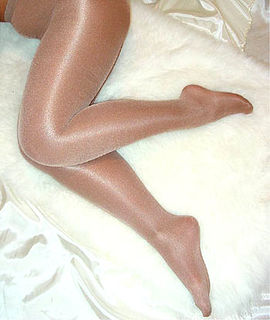Related Research Articles
In computer programming, an infinite loop is a sequence of instructions that, as written, will continue endlessly, unless an external intervention occurs. It may be intentional.

Stockings are close-fitting, variously elastic garments covering the leg from the foot up to the knee or possibly part or all of the thigh. Stockings vary in color, design, and transparency. Today, stockings are primarily worn for fashion and aesthetics, usually in association with mid-length or short skirts.

A compression artifact is a noticeable distortion of media caused by the application of lossy compression. Lossy data compression involves discarding some of the media's data so that it becomes small enough to be stored within the desired disk space or transmitted (streamed) within the available bandwidth. If the compressor cannot store enough data in the compressed version, the result is a loss of quality, or introduction of artifacts. The compression algorithm may not be intelligent enough to discriminate between distortions of little subjective importance and those objectionable to the user.

Pantyhose, called sheer tights, or tights, are close-fitting legwear covering the wearer's body from the waist to the toes. Mostly considered to be a garment for women and girls, pantyhose first appeared on store shelves in 1959 for the advertisement of new design panties as a convenient alternative to stockings and/or control panties which, in turn, replaced girdles.

A jump cut is a cut in film editing in which a single continuous sequential shot of a subject is broken into two parts, with a piece of footage being removed in order to render the effect of jumping forward in time. Camera positions of the subject in the remaining pieces of footage of the sequence should vary only slightly in order to achieve the effect. It is a manipulation of temporal space using the duration of a single shot, and fracturing the duration to move the audience ahead. This kind of cut abruptly communicates the passing of time as opposed to the more seamless dissolve heavily used in films predating Jean-Luc Godard's Breathless, which made extensive use of jump cuts and popularized the technique during the 1960s. For this reason, jump cuts are considered a violation of classical continuity editing, which aims to give the appearance of continuous time and space in the story-world by de-emphasizing editing, but are sometimes nonetheless used for creative purposes. Jump cuts tend to draw attention to the constructed nature of the film. More than one jump cut is sometimes used in a single sequence.
Linear video editing is a video editing post-production process of selecting, arranging and modifying images and sound in a predetermined, ordered sequence. Regardless of whether it was captured by a video camera, tapeless camcorder, or recorded in a television studio on a video tape recorder (VTR) the content must be accessed sequentially.

FL Studio is a digital audio workstation (DAW) developed by the Belgian company Image-Line.

An overlock is a kind of stitch that sews over the edge of one or two pieces of cloth for edging, hemming, or seaming. Usually an overlock sewing machine will cut the edges of the cloth as they are fed through, though some are made without cutters. The inclusion of automated cutters allows overlock machines to create finished seams easily and quickly. An overlock sewing machine differs from a lockstitch sewing machine in that it uses loopers fed by multiple thread cones rather than a bobbin. Loopers serve to create thread loops that pass from the needle thread to the edges of the fabric so that the edges of the fabric are contained within the seam.
Bitmap textures are digital images representing a surface, a material, a pattern or even a picture, generated by an artist or designer using a bitmap editor software such as Adobe Photoshop or Gimp or simply by scanning an image and, if necessary, retouching it on a personal computer.

Windows Movie Maker is a discontinued video editing software program by Microsoft. It was first included in Windows Me on September 14, 2000 and in Windows XP on October 25, 2001. It was a part of the Windows Essentials software suite, and offered the ability to create and edit videos as well as to publish them on OneDrive, Facebook, Vimeo, YouTube, Windows Live Groups and Flickr. It is comparable to Apple’s iMovie.
The term interactive video usually refers to a technique used to blend interaction and linear film or video.

Remix culture, sometimes read-write culture, is a term describing a society that allows and encourages derivative works by combining or editing existing materials to produce a new creative work or product. A remix culture would be, by default, permissive of efforts to improve upon, change, integrate, or otherwise remix the work of copyright holders without their permission. While combining elements has always been a common practice of artists of all domains throughout human history, the growth of exclusive copyright restrictions in the last several decades limits this practice more and more by the legal chilling effect. In reaction, Harvard law professor Lawrence Lessig, who considers remixing a desirable concept for human creativity, has worked since the early 2000s on a transfer of the remixing concept into the digital age. Lessig founded the Creative Commons in 2001, which released Licenses as tools to enable remix culture again, as remixing is legally prevented by the default exclusive copyright regime applied currently on intellectual property. The remix culture for cultural works is related to and inspired by the earlier Free and open-source software for software movement, which encourages the reuse and remixing of software works.

Image stitching or photo stitching is the process of combining multiple photographic images with overlapping fields of view to produce a segmented panorama or high-resolution image. Commonly performed through the use of computer software, most approaches to image stitching require nearly exact overlaps between images and identical exposures to produce seamless results, although some stitching algorithms actually benefit from differently exposed images by doing high-dynamic-range imaging in regions of overlap. Some digital cameras can stitch their photos internally.
The marquee tag is a non-standard HTML element which causes text to scroll up, down, left or right automatically. The tag was first introduced in early versions of Microsoft's Internet Explorer, and was compared to Netscape's blink element, as a proprietary non-standard extension to the HTML standard with usability problems. The W3C advises against its use in HTML documents.

Pannal railway station serves the villages of Pannal and Spacey Houses in the southern suburbs of Harrogate, North Yorkshire, England, equidistant from both. It also serves the village of Burn Bridge, on the opposite side of Pannal. It is located on the Harrogate Line 15 miles (24 km) north of Leeds and operated by Northern who provide all passenger train services.

Cinemagraphs are still photographs in which a minor and repeated movement occurs, forming a video clip. They are published as an animated GIF or in other video formats, and can give the illusion that the viewer is watching an animation. A variation is a video snapshot. Another variation is an audio snapshot.

Vine was an American short-form video hosting service where users could share seven-second-long, looping video clips. It was founded in June 2012; American microblogging website Twitter acquired it in October 2012, before its official release on January 24, 2013. Videos published on Vine's social network could also be shared on different social networking platforms such as Facebook and Twitter. The Vine app was also used to try to browse videos, along with a group of videos that were uploaded by theme, and hoping that users could "trend" videos. Vine competed with other social media services such as Instagram and Pheed.
An online video platform (OVP), provided by a video hosting service, enables users to upload, convert, store and play back video content on the Internet, often via a structured, large-scale system that may generate revenue. Users generally will upload video content via the hosting service's website, mobile or desktop application, or other interfaces (API). An example of an OVP is YouTube. The type of video content uploaded might be anything from shorts to full-length TV shows and movies. The video host stores the video on its server and offers users the ability to enable different types of embed codes or links that allow others to view the video content. The website, mainly used as the video hosting website, is usually called the video-sharing website.
This list includes terms used in video games and the video game industry, as well as slang used by players.
Gradient domain image processing, also called Poisson image editing, is a type of digital image processing that operates on the differences between neighboring pixels, rather than on the pixel values directly. Mathematically, an image gradient represents the derivative of an image, so the goal of gradient domain processing is to construct a new image by integrating the gradient, which requires solving Poisson's equation.
References
- ↑ Khan, Farhat Basir (January 2016). "Cinemagraph: A Fusion of Still Images and Motion Video for Science Communication in a New Media Convergent Ecosystem". JST Vol.04(1-2) [January-March & April-June 2016]. ISSN 2278-2796.
- ↑ Panchal, Kunjal (2020-11-04). "Improved Algorithm for Seamlessly Creating Infinite Loops from a Video Clip, while Preserving Variety in Textures". arXiv:2011.02579 [cs]. doi:10.48550/arxiv.2011.02579.